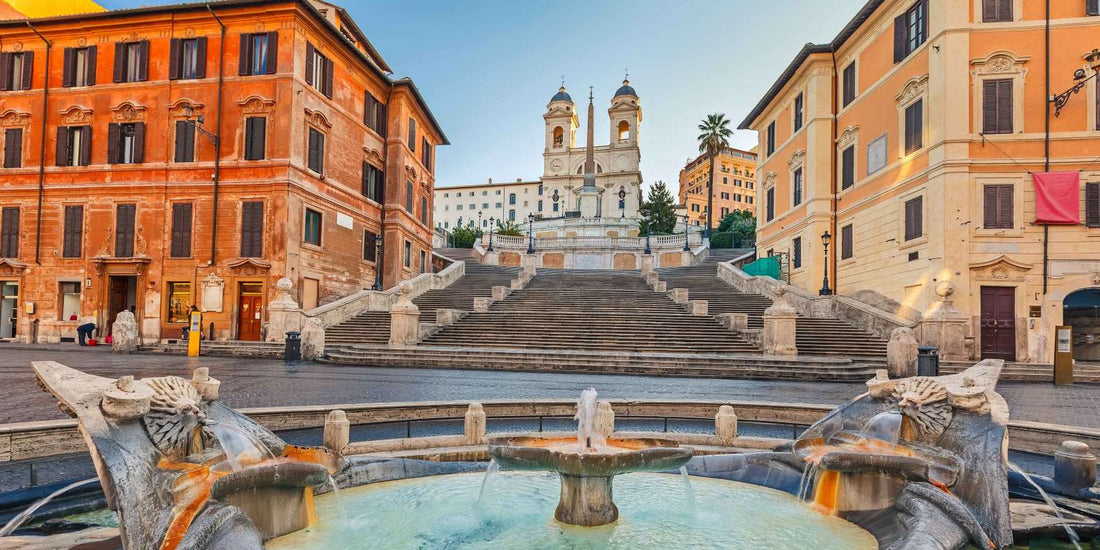
Piazza di Spagna: The Ultimate Guide to Rome's Iconic Spanish Steps
Share
The Spanish Steps in Rome stand as an iconic symbol of the Eternal City's charm and elegance. If you're planning to visit this historic landmark and uncover the stories that it holds, our blog, "The Ultimate Guide to Rome's Iconic Spanish Steps," is your key to a deeper understanding of its significance and the best ways to experience it. Along with coach hire Italy, your experience will be exceptional.
Piazza di Spagna
The Spanish Steps are one of Rome's most iconic landmark, and for good reason. The sweeping staircase that leads up from Piazza di Spagna to the Trinita dei Monti church is a popular spot for tourists and locals alike to relax, take in the views, and people-watch.
They were built in the early 18th century to connect the Piazza di Spagna with the Trinita dei Monti church. The steps were designed by Francesco de Sanctis. And they built over the course of 10 years. They are made up of 135 steps, and they decorated with travertine balustrades and fountains.

The Spanish Steps are a popular spot for tourists to visit because they offer stunning views of Rome. The steps also lead up to the Trinita dei Monti church, which is a beautiful example of Baroque architecture. They are also a popular spot for locals to relax and socialize. Many people come to the steps to read, chat with friends, or simply enjoy the atmosphere.
In addition to being a popular tourist destination, they have also featured in many films and television shows. The most famous example is the film "Roman Holiday," in which Audrey Hepburn's character, Princess Ann, sits on the steps to eat an ice cream cone. The Spanish Steps have also featured in films such as "La Dolce Vita" and "To Rome with Love."
If you are planning a trip to Rome, be sure to add the Spanish Steps to your itinerary. The steps are a beautiful and iconic part of the city, and they offer a great opportunity to take in the sights and sounds of Rome.
History
The Spanish Steps built in the early 18th century to connect the Piazza di Spagna with the Trinita dei Monti church. The steps were designed by Francesco de Sanctis, and they were built over the course of 10 years. They were commissioned by King Philip V of Spain, and they were built as a gesture of goodwill to the Holy See.
The Spanish Steps originally called the "Scalinata di Trinità dei Monti," but they eventually renamed the "Spanish Steps" because of the Spanish Embassy, which located at the bottom of the steps.
They have been a popular tourist destination since they were built. The steps offer stunning views of Rome, and they lead up to the Trinita dei Monti church, which is a beautiful example of Baroque architecture. The Spanish Steps are also a popular spot for locals to relax and socialize. Many people come to the steps to read, chat with friends, or simply enjoy the atmosphere.
Architecture of the Spanish Steps
The Spanish Steps made up of 135 steps, and they are decorated with travertine balustrades and fountains. The steps divided into three sections, and each section is decorated with its own unique design.
The first section of the Spanish Steps is the most famous. This section called the "Scalinata dei Trinità dei Monti," and it is the section that leads up to the Trinita dei Monti church. The Scalinata dei Trinità dei Monti decorated with a series of fountains, and it also flanked by two travertine balustrades.

The second section called the "Scalinata di Trinità dei Monti al Governo Vecchio." This section is located below the Scalinata dei Trinità dei Monti, and it leads down to the Piazza di Spagna. The Scalinata di Trinità dei Monti al Governo Vecchio decorated with a series of bas-reliefs, and it also flanked by two travertine balustrades.
The third section called the "Scalinata di Trinità dei Monti al Governo Nuovo." This section is located below the Scalinata di Trinità dei Monti al Governo Vecchio, and it leads down to the Via Condotti. The Scalinata di Trinità dei Monti al Governo Nuovo decorated with a series of statues, and it also flanked by two travertine balustrades.
Things to do here
yle="font-weight: 400;">There are many things to do at the Spanish Steps. Here are a few ideas:
- >Take in the views. The Spanish Steps offer stunning views of Rome. Be sure to take some time to relax and enjoy the views.
- Visit the Trinita dei Monti church. The Trinita dei Monti church is a beautiful example of Baroque architecture. The church is located at the top, and it is well worth a visit.
- People-watch. The Spanish Steps are a popular spot for people-watching. Be sure to take some time to sit on the steps and watch the world go by.
- Have a picnic. The Spanish Steps are a great spot for a picnic
Other things to do around the Spanish Steps</b>
yle="font-weight: 400;">In addition to the things to do at the Spanish Steps listed above, there are also many other things to do in the surrounding area. Here are a few ideas:
- Visit the Trevi Fountain. The Trevi Fountain is one of the most famous fountains in the world, and it is located just a short walk from the Spanish Steps.
- le="font-weight: 400;">Go shopping on the Via Condotti. The Via Condotti is one of the most famous shopping streets in Rome, and it is located just a short walk from the Spanish Steps.
- le="font-weight: 400;">Visit the Pantheon. The Pantheon is an ancient Roman temple that is located just a short walk from the Spanish Steps.
- le="font-weight: 400;">Visit the Piazza Navona. The Piazza Navona is a beautiful square that is located just a short walk from the Spanish Steps.
<h2>Tips for visiting the Spanish Steps</b>
yle="font-weight: 400;">Here are a few tips for visiting the Spanish Steps:
- <li style="font-weight: 400;">
Be prepared for crowds. The Spanish Steps are a very popular tourist destination, so prepared for crowds.
- Be careful of your belongings. The Spanish Steps are a popular spot for pickpockets, so be careful of your belongings.
- Wear comfortable shoes. The Spanish Steps are quite steep, so be sure to wear comfortable shoes.
- Be respectful of others. The Spanish Steps are a religious site, so be respectful of others.
The Spanish Steps are a must-see for any visitor to Rome. The steps offer stunning views of the city, and they are a great place to relax and people-watch. If you are planning a trip to Rome, be sure to add the Spanish Steps to your itinerary.</span>
How to have the best experience in Piazza di Spagna

The MBS87 coach rental Rome service is a convenient and affordable way to visit Piazza di Spagna, one of Rome's most iconic landmarks. The hop-on hop-off bus tour allows you to see Piazza di Spagna and other major Rome attractions at your own pace. You can get on and off the bus at any stop, and tickets are valid for 24 hours. The bus tour also includes a multilingual audio commentary, so you can learn about the history and culture of Rome as you go.
Book your spot today and experience the magic of Rome!
>>See more: Fontana di Trevi
- Secure the best prices for high-quality car rentals across Europe! For exceptional value and service, please visit us at https://mbs87.com/pages/get-in-touch
- Stay updated with valuable travel tips and insights by following us at this link:https://mbs87.com or our scocial page: https://www.facebook.com/MBS87BusrentalserviceEurope
- Your journey to discovering Europe in comfort and style begins with just one click
